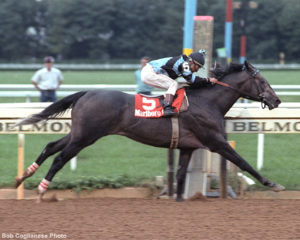
Generally considered a means to an end, the prep season leading up to the Kentucky Derby (G1) serves its purpose if it results in a visit to the Churchill Downs winner’s circle on the first Saturday in May.
The Derby has been won by all sorts: horses that had flawless prep campaigns, those that took a lump or two along the way, and even by some registering their first win of the season. The best-case scenario is obviously an undefeated prep campaign followed by a win in the Derby.
Which Derby winner arguably had the best prep season of all time? It’s a subjective choice, but from the viewpoint of prep season length and diversity in distances and track locales, what happened 40 years ago this spring has to be considered so special as to be almost unrepeatable in today’s environment.
Reigning two-year-old champion Spectacular Bid prepped five times in the span of 78 days prior to the 1979 Kentucky Derby, winning them all by a combined margin of more than 35 lengths. Such a standout was he that his starting odds in four of them were 1-20.

If prepping a confirmed Derby contender five times seems quaint by current standards, what about the fact he kicked off his campaign 40 years ago this week (February 7) in a seven-furlong race after winning four times at a mile and beyond at age two?
The Hutcheson Stakes at Gulfstream Park was the first of the facile victories for ‘The Bid,’ who missed Mr. Prospector’s track record by only three-fifths of a second. The 1 1/16-mile Fountain of Youth (G3) came just 12 days later, and the winning margin that day was 8 1/2 lengths.
The 1 1/8-mile Florida Derby (G1) came 15 days after that and Spectacular Bid won despite what legendary turf columnist Joe Hirsch described an “incredibly inept” ride by 19-year-old jockey Ron Franklin.
The chart footnotes of the Florida Derby read:
“Spectacular Bid banged into the left side of the gate at the start, was allowed to settle, moved along the inside going into the first turn, was steadied and altered course over Sir Ivor Again’s heels midway the turn, accelerated quickly along the backstretch, was forced to steady again leaving the backstretch while trying to get through along the inside, was steadied again midway the turn, was eased back and to the outside, came four wide into the stretch, was hit six times with the whip right-handed at the head of the stretch, bore in slightly, was hit twice left-handed and drew well clear in the final sixteenth.”
“Spectacular Bid was in just about every part of the track except the directors’ lounge…,” Hirsch recalled, yet the gray son of Bold Bidder still won off by 4 1/2 lengths. “If he could overcome so much trouble and still win easily, no matter the opposition, this was a Kentucky Derby winner.”
“It was six riders against one,” Franklin told the New York Times, accusing other riders, specifically Angel Cordero Jr. and Jorge Velasquez, of ganging up on his horse.
“Those other riders lured [Franklin] into a trap along the rail,” Delp offered. “If the horse had been clear on the outside, he’d have won by 25 lengths.”
After debating whether to replace Franklin, considered by Delp a “third son” in his own household, the decision was made by owner Harry Meyerhoff to give the kid another chance.
Rather than pencil in one last prep, Spectacular Bid made two more. The first was the March 24 Flamingo (G1), which turned into another paid workout as the colt coasted by a stakes-record 12 lengths in the nine-furlong event. Unlike the Florida Derby, there were no mishaps in the single lap around the Hialeah oval.
“The critics don’t know this horse like I do,” said Delp when questioned about Spectacular Bid’s busy schedule. “This horse is fresh now, and getting better all the time.”
In the 1 1/8-mile Blue Grass (G1) at Keeneland, run nine days before the Kentucky Derby, Spectacular Bid registered a seven-length victory. As was the case in the Hutcheson, Fountain of Youth, and Florida Derby, the capable but generationally unlucky Lot O’ Gold finished second.
The rest of Spectacular Bid’s story is well known and need not be expounded here. Suffice it to say his example shows there can be a more ambitious and less regimented way of navigating through the prep season and into the Kentucky Derby winner’s circle.


